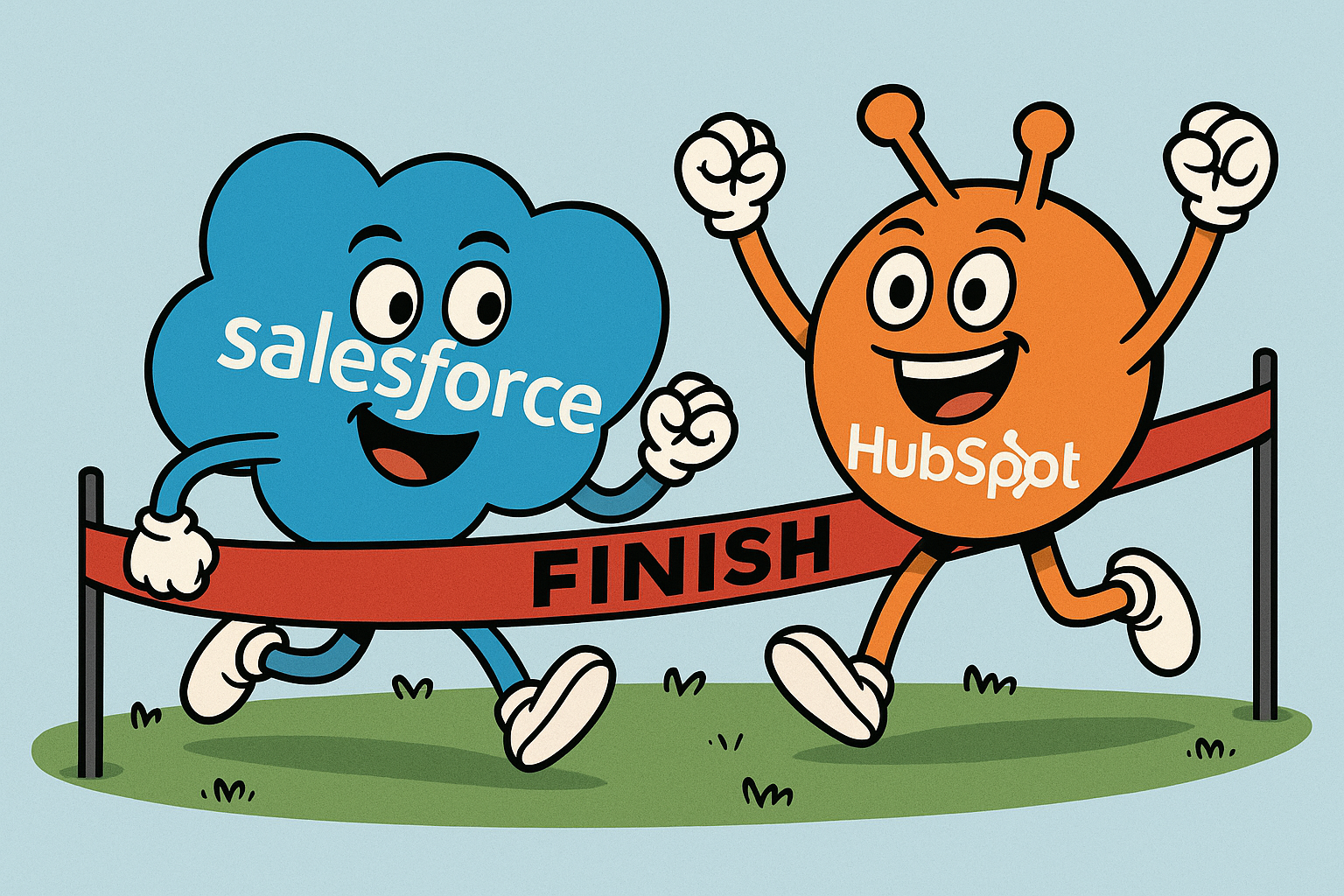HubSpot vs Salesforce: Comparing the Best CRM Platforms for B2B Commercial Teams
When it comes to choosing the right CRM platform to support your B2B sales and marketing efforts, two tools consistently stand out from the crowd: HubSpot and Salesforce (SFDC).
I have had the opportunity to work extensively with both platforms. Typically, Salesforce in larger B2B organisations with complex integrations, and HubSpot in start-ups or scale-ups where ease of use and speed to value are essential. The truth is, I really rate both of them. They each bring something unique to the table, and I have seen them both deliver meaningful commercial results across B2B teams.
This is not a comparison designed to criticise either tool. It is about highlighting the strengths and benefits of each platform from a B2B commercial perspective, focusing on how they support sales, marketing, and the wider revenue function.
HubSpot: Simplicity, Speed and Seamless Native Tools
If I had to describe HubSpot in three words, they would be intuitive, integrated, and immediate.
For early stage B2B businesses or growing companies without a full in-house operations team, HubSpot is often an obvious choice. It provides everything you need to get started. CRM, marketing automation, email marketing, forms, landing pages, reporting, workflows, sequences, templates, snippets. All in one place, with a clean and user friendly interface.
From a B2B sales perspective, HubSpot makes it easy to:
Set up pipelines and deal stages quickly
Use email templates and snippets to create consistency
Automate follow ups using sales sequences
Track emails, meetings and calls with minimal admin effort
On the B2B marketing side, I have seen teams launch complete campaigns using HubSpot. Nurture journeys, landing pages, emails and forms can all be built in just a few hours. The native tools are powerful enough to manage demand generation and lead nurturing without the need for additional platforms early on.
A key strength of HubSpot is that you do not need a large internal resource to use it well. It allows sales and marketing teams to collaborate effectively from the same system without barriers or technical delays.
As businesses scale, the costs can increase. That is especially true as you unlock more advanced features or add more users. However, for many B2B teams, the speed of implementation and the value delivered make it a worthwhile investment.
Salesforce (SFDC): Power, Scale and Deep Integration
Salesforce is the CRM I have worked with most in large B2B organisations. In particular, companies with multiple sales teams, international operations or complex technology ecosystems.
It is powerful and highly flexible. With the right configuration, Salesforce is extremely effective for commercial teams operating across multiple markets, departments or regions.
Where Salesforce really excels is in its ability to support large scale B2B programmes and complex integration needs. Whether you are running a global sales function, integrating with tools like Marketo, Oracle Eloqua or Salesforce Marketing Cloud (previously Pardot), or managing multiple product lines and sales motions, Salesforce can handle it all.
From a sales operations perspective, I have often seen Salesforce work best when combined with specialist tools, such as:
Outreach or Salesloft for outbound sales engagement
Gong or Chorus for sales call intelligence
Clari or Tableau for pipeline visibility and forecasting
Salesforce does have its own native engagement tools, but in larger B2B organisations, pairing it with leading sales enablement platforms tends to offer more functionality and flexibility.
For marketing teams, Salesforce offers deep integrations with enterprise grade tools. It supports advanced segmentation, multi-channel campaigns and complex reporting. With the right structure and support, it provides full visibility across the lead lifecycle and into revenue performance.
It is also worth mentioning that Salesforce’s AI capabilities have made impressive progress in recent years. Through tools like Einstein, teams can access predictive lead scoring, pipeline analytics and proactive insights to support revenue growth.
When Does Each Make Sense?
If you are a start-up or a growing B2B company with limited operational support and a need for speed, HubSpot is an excellent option. It is simple to use, fast to implement and brings both sales and marketing together into one easy to manage platform.
If you are a large B2B organisation with multiple teams, bespoke processes or advanced reporting needs, Salesforce is often the right choice. It allows greater control, flexibility and integration with your wider technology stack.
In my experience:
HubSpot works brilliantly for small to mid-sized B2B organisations that value simplicity and speed
Salesforce is usually better suited to larger B2B businesses that need scale and deep integration
That said, I have seen HubSpot perform well in bigger organisations too. Equally, I have seen Salesforce successfully implemented in growing companies with strong operational support. Both platforms are evolving fast and expanding into new segments of the market.
Other CRM Tools Worth Mentioning
While HubSpot and Salesforce are my personal go-to platforms, there are other strong CRM tools out there that may suit particular B2B needs:
Pipedrive for smaller sales teams looking for a visual pipeline
Zoho CRM as a cost effective solution with broad functionality
Freshsales for newer B2B teams wanting a clean user experience
Monday.com CRM for teams looking to blend sales and project management
That said, when building a scalable B2B revenue technology stack, the combination of either HubSpot or Salesforce at the core is what I have seen deliver the most success.
Final Thoughts: Choose What Fits Your Commercial Model
The best CRM is the one that fits your stage of growth, your team’s capability and your go to market model.
Both HubSpot and Salesforce offer world class solutions for B2B organisations. It is not about which one is better in general. It is about which one is better for you at this moment, based on your goals and commercial priorities.
If you are looking for support with HubSpot, support with Salesforce, or guidance on how to choose the right CRM for your sales and marketing teams, I would be happy to help.

